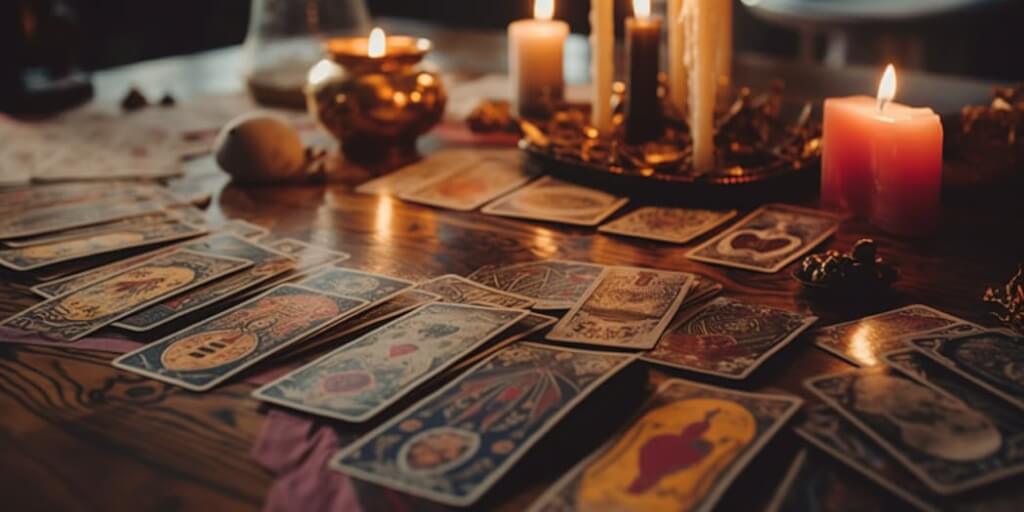The emergence of tarot cards can be traced back to the captivating and exquisitely designed decks that appeared in Europe during the mid-15th century. Originally devised for recreational activities like ‘tarocchi’ in Italy, ‘tarot’ in France, and ‘tarock’ in German-speaking regions, these cards gradually transitioned into tools for divination by the 18th century.
The early iterations of tarot decks were meticulously crafted to reflect the cultural and artistic sensibilities of their time. They showcased prominent figures from the royal court, symbols derived from Christianity, and snapshots of everyday life. Notable among the surviving ancient decks are the Visconti-Sforza and the Sola-Busca tarot, cherished treasures from Italy.
Evolution and Religious Influences
Tarot cards have undergone significant evolution over time, incorporating diverse religious, philosophical, and esoteric influences. One notable deck that exemplifies this amalgamation is the Rider-Waite-Smith deck, which emerged in the early 20th century. This deck masterfully blends elements from Christianity, Kabbalah, Hermeticism, astrology, and alchemy, giving rise to a rich tapestry of symbolism and interpretation.
To better understand the religious influences on tarot imagery and interpretation, let’s explore the key elements associated with different belief systems in a table:
Key Influences on Tarot Imagery and Interpretation
| Influence | Elements |
|---|---|
| Christianity | Saints, Angels, Devil, concepts of Sin and Redemption |
| Kabbalah | Tree of Life, Sephiroth, Paths, Divine Names |
| Hermeticism | Elements, Principles of Correspondence, Duality |
| Astrology | Zodiac Signs, Planets, Houses |
| Alchemy | Transmutation, Elements, Phases |
It is essential to note that the incorporation of these influences does not imply a direct religious origin for tarot cards. Instead, it underscores the tarot’s diverse historical context, interweaving threads from various belief systems.
The influence of Christianity is evident in the inclusion of saints, angels, and concepts such as sin and redemption within tarot card imagery. These elements provide a framework for exploring moral and ethical themes within readings.
- Kabbalah: a mystical tradition within Judaism, contributes symbolic elements like the Tree of Life, Sephiroth (emanations of divine energy), paths, and divine names. These concepts offer a framework for understanding the interconnectedness of the spiritual and material realms;
- Hermeticis: a philosophical and occult tradition, introduces the principles of correspondence and duality. These principles allow for the exploration of connections between different aspects of life and the reconciliation of opposing forces;
- Astrology: an ancient system of divination based on celestial bodies, provides tarot with imagery related to zodiac signs, planets, and houses. These astrological associations add layers of meaning and help to interpret the cards within the context of cosmic influences;
- Alchemy: a philosophical and proto-scientific tradition, contributes ideas related to transmutation, elements, and phases. These concepts offer a framework for personal transformation and growth, reflecting the alchemical process of turning base materials into spiritual gold.
By examining these key influences on tarot imagery and interpretation, we gain a deeper appreciation for the intricate tapestry of beliefs and ideas that have shaped the evolution of tarot cards throughout history.
The Major and Minor Arcana
The 78-card tarot deck is divided into the Major Arcana (22 cards) and the Minor Arcana (56 cards). Each of these segments has unique symbolic significance.
Major Arcana
The Major Arcana, sometimes called the “trumps,” consists of 22 cards each symbolizing a distinct stage or experience in the spiritual journey known as the “Fool’s Journey.” Each card, from ‘The Fool’ to ‘The World’, is filled with rich symbolism derived from various spiritual and esoteric traditions.
Major Arcana Cards and Their Key Symbolism
| Card | Key Symbolism |
|---|---|
| The Fool | Innocence, new beginnings, free spirit |
| The Magician | Manifestation, resourcefulness, power |
| The High Priestess | Intuition, sacred knowledge, divine feminine |
| The Empress | Femininity, nature, nurturing |
| The Emperor | Authority, structure, solid foundation |
| The Hierophant | Spiritual wisdom, religious beliefs, conformity |
| The Lovers | Love, harmony, relationships, values alignment |
| The Chariot | Control, will power, success, action |
| Justice | Fairness, truth, law, cause and effect |
| The Hermit | Soul-searching, introspection, being alone |
| Wheel of Fortune | Destiny, unexpected events, karma |
| Strength | Bravery, compassion, focus, inner strength |
| The Hanged Man | Perspective, contemplation, sacrifice |
| Death | Endings, change, transformation, transition |
| Temperance | Balance, moderation, patience, purpose |
| The Devil | Addiction, materialism, playfulness or bondage |
| The Tower | Disaster, upheaval, sudden change |
| The Star | Hope, spiritual guidance, renewal |
| The Moon | Illusion, fear, anxiety, subconscious |
| The Sun | Positivity, fun, warmth, success, vitality |
| Judgement | Judgement, rebirth, inner calling |
| The World | Completion, integration, accomplishment, travel |
Minor Arcana
The Minor Arcana is an integral part of the Tarot deck and consists of four suits: Cups, Pentacles, Swords, and Wands. These suits are associated with different elements, namely water, earth, air, and fire, respectively. The Minor Arcana cards provide insights into the day-to-day experiences and events in our lives, complementing the broader themes explored by the Major Arcana cards.
Each suit in the Minor Arcana contains ten numbered cards and four court cards. The numbered cards range from Ace to Ten, representing various stages or levels of the suit’s energy. The court cards, on the other hand, depict individuals or personalities within the respective suit. The four court cards in each suit are the King, Queen, Knight, and Page.
To present the information in a more organized manner, here’s a table summarizing the suits and their associated elements:
| Suit | Element |
|---|---|
| Cups | Water |
| Pentacles | Earth |
| Swords | Air |
| Wands | Fire |
Conclusion
Tarot cards have evolved from a blend of religious and philosophical influences, devoid of any exclusive affiliation with a single religion. Their global popularity reflects their ability to transcend religious boundaries, becoming a diverse and widely embraced spiritual tool. While attitudes towards tarot may differ among various religions, its value remains intact as a means for introspection, meditation, and divination, catering to the needs of many seekers worldwide.
Tarot cards’ origins lie in multiple religious and philosophical traditions, making them a universally relevant spiritual tool. Despite differing views within various religions, tarot’s significance persists, serving as a valuable resource for those seeking self-reflection and divination.
FAQs
Not at all. Tarot cards are not exclusive to any religion. They are tools for introspection and personal growth, and their usage is independent of one’s religious affiliation.
Some conservative factions within various religions (such as Christianity, Islam, or Judaism) may disapprove of tarot due to its association with divination and occultism. However, it is subjective and varies from one individual to another within each religious group.
While often associated with future prediction, tarot cards are more accurately tools for guidance. They can suggest potential outcomes based on current circumstances but do not offer fixed predictions. The future, according to tarot philosophy, is not set in stone but is a result of one’s actions and decisions.
Learning to read tarot involves understanding the symbolism of each card, learning various spread layouts, and honing one’s intuition. Various resources, including books, online courses, and workshops, can guide a beginner in learning tarot.


No Responses